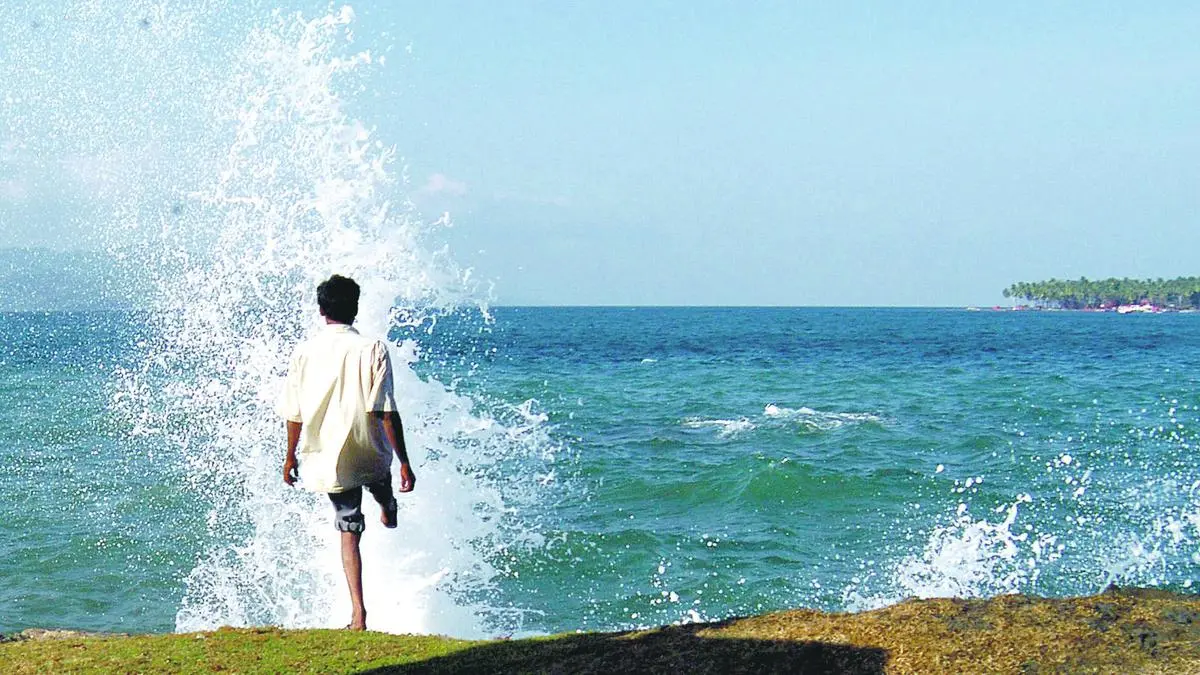Two decades ago, when the Indian Ocean tsunami wiped out their remote village of Pulobhabi on Great Nicobar’s western coast, nine Nicobarese defied the odds and survived the deadly waves. Their lifeline? The forest—their oldest ally—sheltered, nourished, and sustained them. For nearly six weeks, they relied entirely on its bounty, navigating its depths until they emerged on the island’s eastern coast at Campbell Bay, where rescuers found them and brought them to relief camps.
The ancient forests of Great Nicobar—a UNESCO Biosphere Reserve and the ancestral home of the Nicobarese and Shompen , a particularly vulnerable tribal group (PVTG)—have sustained these historically isolated communities for millennia. Today, this lifeline faces an existential threat from a Rs.81,800 crore megaproject set to transform the island into a “global destination of business, trade, and leisure”.

Official estimates put the number of trees to be felled for the megaproject at 8–10 lakh, but ecologists warn that the true toll could be as high as 10 million. What does this loss of forest mean for Great Nicobar’s indigenous people? When I asked Mathias , one of the nine tsunami survivors from Pulobhabi—whose ancestral village now lies in the shadow of the megaproject—his answer cuts to the core: “The death of life”. His words foretell a catastrophe.
To grasp its magnitude, we must ask: What is a forest to the people who call it home? Is it merely a resource, or do they share some deeper, inseparable bond with it? And when that bond is severed, what disappears forever? Borne of a bamboo stem My ethnographic research in the Nicobar has revealed the profound spiritual connection its indigenous inhabitants share with their lands, forests, and ocean. To them, these are not just physical spaces but living entities, infused with spirits and inseparable from their way of life. The forest is more than just trees.
It is the foundation of their identity, the taproot of their vitality, and a sacred sanctuary where the social, natural, and divine realms converge. Above all, it is family. This bond is embedded in their cosmology and creation stories, shaping their way of life for generations.
Also Read | The Great Nicobar Project: A costly miscalculation? One such creation story from Great Nicobar tells of a time when the island lay uninhabited, until a boy descended from the sky and vanished deep into the earth. Days later, a lemon shoot emerged, growing into a towering tree heavy with flowers and fruit. From the lemon seeds of its northern branches sprang the ancestors of the Kondul, Teressa, Trinket, and Nancowry islanders, while the seeds of its southern branches gave rise to the people of Great Nicobar.
Over time, however, a rift grew between them—a divergence in thought and way of life. One group, now known as the Shompen, retreated deep into the jungle. The other, the Nicobarese, settled along the coasts.
This story is more than just a tale of origin. The lemon tree, with its roots anchored in the earth and its branches reaching skyward, symbolises the people’s shared identity and enduring bond with nature. It serves as a reminder that the survival of these Indigenous communities is intricately linked to the forests and land that have sustained them for generations.
A Nicobarese boy during under water fishing. | Photo Credit: By Special Arrangement A similar folktale from Car Nicobar tells of a great deluge that drowned all but one man, who survived by climbing the tallest tree. When the waters receded, he spotted a lone bitch perched on another tree and took her as his wife.
From their union, the island was repopulated. Though mythical, the tale carries a deeper truth: the interconnectedness of humans, animals, and trees. This kinship with nature is not unique to the Nicobarese.
Several indigenous societies share deep connections with the flora and fauna of their homelands. The Popol Vuh , the sacred text of the K’iche’ Maya (indigenous people of the Americas), narrates how the gods created humans from maize, the region’s staple food. To the K’iche’ people, animals are not just wild creatures but neighbours with agency.
Through stories such as these, the Popol Vuh offers a window into pre-Columbian Mesoamerica, where nature and humanity were inseparably woven together. Similarly, the Great Andamanese trace their lineage to bamboo. They believe that Phertajido—the first man of the Andamans—was born from the hollow of a bamboo stem.
For them, birds are not merely creatures of the sky but the reincarnated spirits of their ancestors. So deeply held is this belief that hunting birds is unthinkable. Andamans, replayed For indigenous communities, the forest is more than a home or a source of sustenance: it is a realm of reverence, reciprocity, and deep belonging.
The forest is not a resource to be plundered: it is an ancestral guardian that nurtures and protects. And in return, it must be honoured and safeguarded. Indigenous communities have waged spirited battles to protect their forests and commons, often at great personal cost.
The Chipko Andolan, the Narmada Bachao Andolan, the Jungle Bachao Andolan, the Niyamgiri movement, the Hasdeo Aranya resistance, the Nyishi and Adi opposition to dams, and movements against palm oil plantations and deforestation in northeast India are among the many historical and ongoing indigenous struggles. Some of their struggles, however, have remained largely unknown. For instance, when the British colonised the Andaman Islands in the 19th century and began clearing forests to establish a penal colony, the Great Andamanese did not stand by as their homeland was destroyed.
Armed with little more than bows and arrows, they waged a fierce resistance against the mightiest empire—but at a terrible cost. Ruthless massacres and foreign diseases brought them to the brink of extinction. After India’s Independence, this destruction only intensified.
Ancient tropical forests were cleared for infrastructure projects and the resettlement of mainland settlers. The Jarawas, who had long defended their ancestral lands, fiercely resisted this encroachment. Their defiance, however, came at a tragic cost—many were electrocuted while opposing the Andaman Trunk Road, a project that cut through their forests, scarring not just the land but their very existence.
Such Indigenous resistance is more than a fight for land, forests, or resources—it is an assertion of identity, a stand against erasure. For Indigenous peoples, the forest is not just essential to life; it is life itself—breathing through their way of living, enduring in their memories, and flowing through their traditions. To sever this bond is to unravel the very fabric of their existence.
The loss of the forest is not merely an ecological catastrophe; it is the annihilation of a people’s history, culture, and way of being. Ironically, the champions of the Great Nicobar megaproject refuse to learn from history: the destruction of both forests and indigenous people of the Andamans. Instead, they seem determined to repeat it in Nicobar.
The vigilant black stone Indigenous people have long been at the forefront of protecting the earth. Though they comprise just 6 per cent of the global population—about 476 million people—their territories span nearly 22 per cent of the planet’s land surface and sustain 80 per cent of its biodiversity. Their knowledge and practices, honed over generations, are vital to preserving fragile ecosystems.
For centuries, the Nicobarese have safeguarded Great Nicobar’s ecosystems, guided by the belief that all beings—living and non-living—possess spirit and agency. This worldview is not merely an abstract idea but a way of life, shaping their relationship with nature. During my fieldwork in Little Nicobar, I went fishing with my Nicobarese friend, Gilbert.
Using only a hook and line, he spent hours catching just a few fish. Curious, I asked why he didn’t use a small-eye net. “If we use a net, we will catch plenty of fish in no time, more than we need.
Some will surely go to waste. And the god of the ocean will not be pleased with that”, he replied. In an ocean teeming with fish—where they grow old and die, often untouched—his words offer an invaluable lesson in sustainable management.
In an intermediate shelter a Nicobari tribal family is engaged in a family get-together celebration in Teressa Island on June 02, 2005. | Photo Credit: V. GANESAN The Nicobarese culture is rich with practices and taboos that have safeguarded nature for generations.
Take, for instance, chat-mat —a tree in the forests of Great Nicobar , believed to house a spirit. To harm it—by cutting its limbs or wounding its bark—is to invite a curse: swollen eyes and a body covered in eruptions like chickenpox. For the Nicobarese, this is not mere superstition but a sacred covenant with the forest—a reminder that it is alive, pulsing with spirits that watch over all who dwell within it.
Similarly, Great Nicobar’s forests hold an enigmatic black stone, tirah , that lies in silent vigilance—believed to be alive. To disturb its peace—by shouting, cutting wood, or showing any sign of disrespect—is to invite grave consequences: a raging fever, blood vomiting, even death. This belief is not merely rooted in fear but in a deep understanding of the interconnectedness of all things—where even a stone holds power, purpose, and a place in the sacred balance of life.
Beyond the forests, in the restless waters of the sea, another creature commands deep reverence: the hiput , dugong. To spear a hiput is to shatter the harmony of the elements, unleashing chaos. The sea itself is believed to mourn the loss, its grief manifesting in violent storms and cyclones ( labifui ), punishing those who dare spill the blood of an innocent creature.
Even entire islands in Nicobar are imbued with spiritual significance and fiercely protected by the Nicobarese. Menchal and Meroë Islands—known to them as Pingaeyak and Piruii —are officially recorded as uninhabited in government documents. Yet, for the Nicobarese of Great and Little Nicobar, these islands are vital lifelines, serving as crucial resource repositories over which they hold traditional rights.
Menchal, or Pingaeyak , is believed to be the dwelling place of a powerful spirit that watches over the island. For the Nicobarese, it is not merely an island but a sacred realm, alive with forces that demand reverence and care. Similarly, Meroë, or Piruii , is steeped in legend, said to be home to a mythical islander community.
The protection of these islands is enshrined in spiritual belief systems and upheld through age-old practices of sustainable natural resource management, ensuring their sanctity remains untouched. In the Nicobarese worldview, the social, natural, and spiritual realms are inseparable, reflecting a deep connection to nature—one rooted not in ownership, but in stewardship. In a world increasingly driven by exploitation, Great Nicobar offers a profound lesson: some places are not meant to be conquered or commodified but cherished and preserved.
Where trees once roamed To the Nicobarese, nature is not to be tamed or exploited. As a sentient, interconnected being, it listens, watches, and responds. This belief lies at the heart of their worldview, shaping a code of ethics—an ecological wisdom passed down through generations.
To harm the forest, land, or sea is not merely an act of destruction; it is an act of defiance against the very forces that sustain life. And what happens when these forces are defied? A Nicobarese folktale offers a telling answer. Long ago, trees were not bound to the earth—they roamed freely, heeding the commands of humans.
People harnessed them as living vehicles, tying bundles of goods to their branches and guiding them from the jungle to their villages. Some even rode upon their sturdy limbs. Also Read | Great Nicobar development projects disregard risk in earthquake-prone area But one day, as the trees carried the heavy loads, they swayed and bumped into one another.
Amused, the people laughed mockingly, wounding the trees’ pride. Angered, the trees refused to take another step. From that day on, they stood still, leaving humans to bear their own burdens—forever reminded of the nurturing bond they once shared with trees and the cost of taking it for granted.
As the spectre of the megaproject looms over the Great Nicobar, we must ask: What dies when a forest falls? What does felling 10 million trees in an ancient tropical forest mean for India? The answer lies in the lessons we refuse to learn—the storms we summon, the fragile ecological balance we shatter—all in the name of development. Climate change, droughts, floods, landslides, species extinction—each a cost of our recklessness—is already upon us. The Great Nicobar megaproject isn’t just a local catastrophe—it’s a national crisis.
It threatens to erase one of India’s last great biodiversity hotspots, obliterate carbon sinks that shield us from climate chaos, and sever the sacred bond between Indigenous communities and nature. Progress built on nature’s ruins isn’t progress—it’s a reckless gamble with the future. And it’s one we can no longer afford.
Ajay Saini is an anthropologist with extensive research experience in the Andaman and Nicobar Islands. He teaches at the Indian Institute of Technology Delhi. CONTRIBUTE YOUR COMMENTS SHARE THIS STORY Copy link Email Facebook Twitter Telegram LinkedIn WhatsApp Reddit.
Environment

Mathias calls it ‘the death of life’
A tsunami survivor’s dire warning as Great Nicobar’s sacred forest faces obliteration by the ‘megaproject’.















